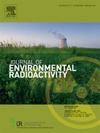基于人工神经网络和蚁群优化的伽马射线辐射光谱异常检测
IF 2.1
3区 环境科学与生态学
Q3 ENVIRONMENTAL SCIENCES
引用次数: 0
摘要
环境监测系统中异常放射源的准确检测对于辐射防护和核安全至关重要。本研究解决了从自然背景波动中区分异常辐射信号的基本挑战,特别是在低源背景比下。我们提出了一种新的机器学习方法,用于伽马射线光谱的异常检测,该方法将神经网络建模与生物启发优化相结合。该方法创新地将辐射光谱划分为两个互补的子光谱,利用训练好的神经网络建立它们的背景相关性。通过测量值与神经网络预测值之间的显著偏差来识别异常。一个关键的创新是集成蚁群优化,以选择光谱分区,提供最大的准确性。该系统使用来自分布式辐射探测器的经验数据进行了严格的评估,包括背景测量和来自常见放射源(137Cs和57Co)的光谱。对比实验证明了优于现有基准方法的性能,特别是在低源背景比下的优势。该技术通过提高对微弱异常信号的灵敏度和使用标准探测器网络的实际部署潜力,提高了辐射监测能力。这些改进与环境监测和安全应用特别相关,在这些应用中,早期检测辐射异常至关重要。本文章由计算机程序翻译,如有差异,请以英文原文为准。
Anomaly detection in gamma-ray radiation spectra using artificial neural network and ant colony optimization
Accurate detection of anomalous radioactive sources in environmental monitoring systems is critical for both radiological protection and nuclear security. This study addresses the fundamental challenge of discriminating anomalous radiation signals from natural background fluctuations, particularly at low source to background ratios. We present a novel machine learning approach for anomaly detection in gamma-ray spectra that combines neural network modeling with bio-inspired optimization. The method innovatively partitions radiation spectra into two complementary sub-spectra, using a trained neural network to establish their background correlation. Anomalies are identified through significant deviations between measured values and neural network predictions. A key innovation is the integration of ant colony optimization to select spectral partitions that provide maximum accuracy. The system was rigorously evaluated using empirical data from distributed radiation detectors, incorporating both background measurements and spectra from common radioactive sources (137Cs and 57Co). Comparative experiments demonstrate superior performance over existing benchmark methods, with particular advantage in low source to background ratios. The proposed technique advances radiation monitoring capabilities by providing enhanced sensitivity to weak anomalous signals and practical deployment potential using standard detector networks. These improvements are particularly relevant for environmental monitoring and security applications where early detection of radiation anomalies is critical.
求助全文
通过发布文献求助,成功后即可免费获取论文全文。
去求助
来源期刊

Journal of environmental radioactivity
环境科学-环境科学
CiteScore
4.70
自引率
13.00%
发文量
209
审稿时长
73 days
期刊介绍:
The Journal of Environmental Radioactivity provides a coherent international forum for publication of original research or review papers on any aspect of the occurrence of radioactivity in natural systems.
Relevant subject areas range from applications of environmental radionuclides as mechanistic or timescale tracers of natural processes to assessments of the radioecological or radiological effects of ambient radioactivity. Papers deal with naturally occurring nuclides or with those created and released by man through nuclear weapons manufacture and testing, energy production, fuel-cycle technology, etc. Reports on radioactivity in the oceans, sediments, rivers, lakes, groundwaters, soils, atmosphere and all divisions of the biosphere are welcomed, but these should not simply be of a monitoring nature unless the data are particularly innovative.
 求助内容:
求助内容: 应助结果提醒方式:
应助结果提醒方式:


